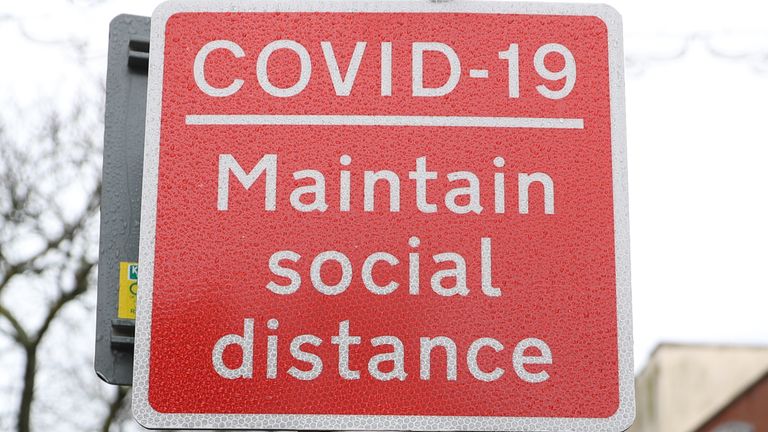Compliance with coronavirus rules has risen sharply since December and is now at its highest point since the first lockdown, according to a major new survey seen by Sky News.
The results cast doubt on the government’s claims that rule-breaking is contributing to a rise in COVID-19 deaths, after ministers and senior police officers warned that enforcement would be increased to ensure compliance.
But while the restrictions are being followed by most people, the study confirmed “rule-bending” remains as commonplace as throughout the pandemic, with a large minority adding their own “modifications” to the rules, especially when it comes to meeting other people and self-isolation time.
The COVID-19 Social Study, which collected responses from more than 70,000 participants, found that the number of people reporting “majority compliance” – that is, following most or almost all of the rules – rose to 96% for the week ending 10 January, which was the highest figure since April.
And the number of people saying that they were in “complete compliance” with the rules rose to 56%, the highest figure since May.
“Compliance is really good,” said Dr Daisy Fancourt of University College London, which conducts the study.
“The fact that we’re still seeing rising virus cases suggests that compliance on its own is not enough.”
She added: “This lockdown is less strict than the lockdown last spring yet the virus is more contagious, so it might be that behaviours that we could get away with six months ago simply aren’t working with the new variant.
“It suggests we might need tighter measures to get on top of this.”
The rule people said they broke most often was meeting up with more than the recommended number of people outdoors – something 16% of people said they never, rarely or only occasionally followed.
Almost as many people said they met with more than the recommended number of people indoors – a more dangerous social activity.
However, the vast majority of people said they always followed both of these rules, and other guidance such as handwashing, maintaining social distance and wearing a face mask were followed very closely.
Analysis by Sky News found that movement in London, Birmingham and Manchester was also at its lowest point since the first lockdown, suggesting that the restrictions were being followed.
“We hear a lot about breaking the rules,” said Dr Fancourt, “but what we’re finding from this data is that people who are following the rules are part of the majority.”
“If you’re not complying you’re letting the side down, because most of us are managing it,” she added.
Understanding was a barrier to compliance, the study found.
Although broad understanding of the rules had grown in recent months, rising from 65% in mid-December to 74% in the week of 4 January in England, very few people said they understood the rules completely.
Just 27% in the week of 4 January said they did, compared with 18% across November and December.
It comes amid a debate over the particular issue of exercise after the prime minister was seen going for a cycle ride seven miles from his home.
Asked whether adherence to the rules was affected by this kind of behaviour, Dr Fancourt said it was “singularly unhelpful” because it drew attention to “grey zones” in the rules.
“We have to have clear messaging,” she said. “Caveats make it really hard for people to know if they’re acting within the rules or not.”
The study found that compliance was better when the rules were stricter.
During the periods when the tier system was in force in England, compliance was highest in those areas in higher tiers, yet lowest in tiers where restrictions were looser, something the researchers put down to the fact that the rules were “more open to interpretation” and “the importance and seriousness of following the measures” was not as clear.
This pattern held true across all age groups, genders and income groups, yet there were significant differences in compliance between different social and demographic groups.
There was a marked gender gap, with 53% of men saying they complied with all rules, compared with 60% of women. Young men were the least likely of all age groups to comply.
Income also made a difference, with 53% of people in households with an income greater than £30,000 saying they complied completely with the rules, compared with 59% of people in households with an income lower than that.
Significantly, only 49% of key workers said they were able to follow all the rules, compared with 59% of other workers.
“One reason for this may be due to social contact being more ‘normalised’ for key workers, and so they are less able or willing to always stick to social distancing rules,” said Dr Alex Crozier, a COVID-19 researcher.
“More importantly perhaps than general compliance with the more general blanket rules, is that key workers and those of a lower socio-economic class, or those who have faced greater hardship during the pandemic, are associated with lower adherence to test/trace/isolate.
“It doesn’t matter how many of the rest of the population follow the rules, if infectious key workers cannot afford, or are unable to, to self-isolate.”
The COVID-19 Social Study found that only 62% of people said they were isolating for the recommended number of days when they developed symptoms, but did not give statistics for keyworkers.
The study said “13% are not isolating at all when they develop symptoms, 16% are only isolating for one to five days”.
Adherence to this most crucial rule did not form part of the government’s tougher stance on enforcement.


